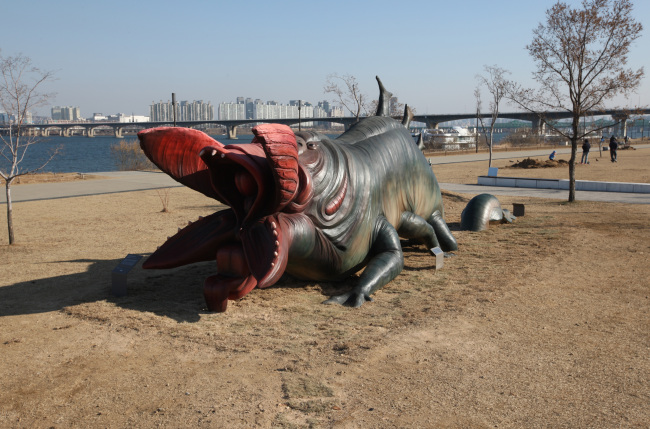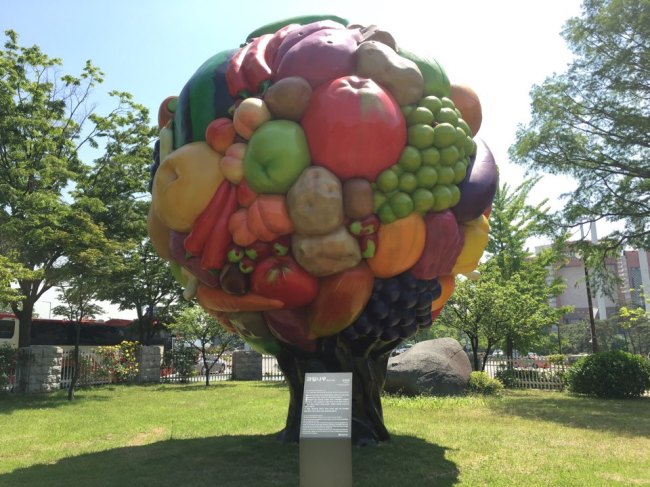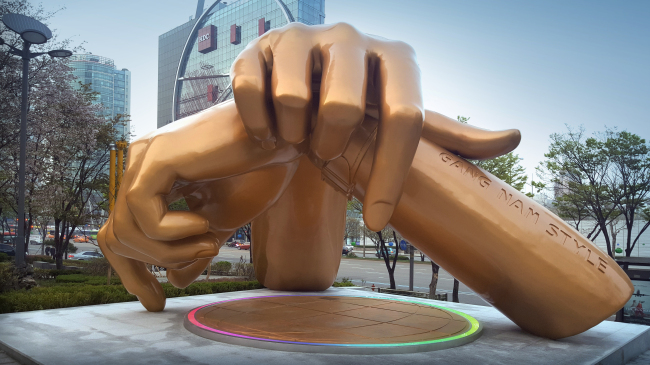From the iconic Statue of Liberty in Manhattan to the 3-ton bronze sculpture Charging Bull in Wall Street, New York City is famous for its statues that have become popular landmarks.
With hopes of constructing landmarks on par with those of New York, Seoul City kicked off a grand project last year. The city allocated about 700 million won ($590,000) to building unique landmarks in Seoul.
In January 2015, a 10-meter-high, 5-ton sculpture of the monster featured in the movie “The Host” (2006) was unveiled at Yeouido Han River Park.
With hopes of constructing landmarks on par with those of New York, Seoul City kicked off a grand project last year. The city allocated about 700 million won ($590,000) to building unique landmarks in Seoul.
In January 2015, a 10-meter-high, 5-ton sculpture of the monster featured in the movie “The Host” (2006) was unveiled at Yeouido Han River Park.

Located between Mapo and Wonhyo Bridge, the sculpture was modeled after the character in the film by director Bong Joon-ho, which features a monster created after researchers dump a toxic chemical into the Han River.
Although Seoul City spent about 108 million won to build it, the public complained the statue looked “too ugly” and “too realistic,” with some even saying the statue has a negative impact on the atmosphere at the Han River.
Another sculpture, “Fruit Tree,” was installed in front of the National Assembly in April 2015. The 7-meter, 2.5-ton tree has a mix of vegetables and fruits hanging on it -- including carrots, potatoes, apples and peaches -- and resembles the shape of a brain.
Although Seoul City spent about 108 million won to build it, the public complained the statue looked “too ugly” and “too realistic,” with some even saying the statue has a negative impact on the atmosphere at the Han River.
Another sculpture, “Fruit Tree,” was installed in front of the National Assembly in April 2015. The 7-meter, 2.5-ton tree has a mix of vegetables and fruits hanging on it -- including carrots, potatoes, apples and peaches -- and resembles the shape of a brain.

“The tree’s variety of colorful fruits and vegetables underlines a message of abundance, harmony, happiness and dream,” reads a signboard next to the statue.
The tree first appeared as part of a cultural exhibition hosted last year. Then it was decided that it should remain inside the Assembly as an attraction for visitors, according to the National Assembly Secretariat.
In December, the sculpture was moved to the far-east corner in front of the Memorial Hall of the Assembly. Its relocation cost 17 million won, in addition to the Ministry of Culture, Sports and Tourism’s 120 million won installation fee.
A lawyer, who worked three years at the Assembly, said, “The statue itself does not contain any meaning related to the works of the parliament.”
“It may look attractive to artists, but I think (to the public), the installation was just waste of public money,” he added, wishing to remain unnamed.
In late April, a giant sculpture dedicated to the hit song “Gangnam Style” was unveiled in front of the multipurpose cultural venue Coex in Samseong-dong, southern Seoul.
Modeled after the song’s signature “horse-riding” dance move, the 5-meter-tall bronze sculpture features two overlapping fists. When sensors below the statue detect movement, lights automatically turn on as “Gangnam Style” is played.
The tree first appeared as part of a cultural exhibition hosted last year. Then it was decided that it should remain inside the Assembly as an attraction for visitors, according to the National Assembly Secretariat.
In December, the sculpture was moved to the far-east corner in front of the Memorial Hall of the Assembly. Its relocation cost 17 million won, in addition to the Ministry of Culture, Sports and Tourism’s 120 million won installation fee.
A lawyer, who worked three years at the Assembly, said, “The statue itself does not contain any meaning related to the works of the parliament.”
“It may look attractive to artists, but I think (to the public), the installation was just waste of public money,” he added, wishing to remain unnamed.
In late April, a giant sculpture dedicated to the hit song “Gangnam Style” was unveiled in front of the multipurpose cultural venue Coex in Samseong-dong, southern Seoul.
Modeled after the song’s signature “horse-riding” dance move, the 5-meter-tall bronze sculpture features two overlapping fists. When sensors below the statue detect movement, lights automatically turn on as “Gangnam Style” is played.

The Gangnam-gu Office spent about 410 million won to build the two fists. In the district office’s day trip guide for Gangnam, the landmark is listed as a tour spot. But public reception has been lukewarm.
“At first, I thought it was an advertisement for a watch,” said Park Seo-yeon, a resident in neighboring Samseong-dong.
“I think it may attract some foreigners, but definitely not many locals. Although Psy’s ‘Gangnam Style’ song literally swept the globe, I think those two hands look grotesque and (it is) really random (for them) to be placed in the middle of the street,” she added.
Seoul City said that it would review the current landmark statues by setting up an advisory panel on public art.
“We have not had a supervising team that covers public art so far. So we were not able to review (the appropriateness of) such statues or discuss budgets,” said an official from Seoul City’s Design Policy department.
“But we will continue to install more landmarks, so visitors can be reminded of Seoul through them, just like people flock to Paris to visit Eiffel Tower,” he added.
By Kim Da-sol (ddd@heraldcorp.com)
“At first, I thought it was an advertisement for a watch,” said Park Seo-yeon, a resident in neighboring Samseong-dong.
“I think it may attract some foreigners, but definitely not many locals. Although Psy’s ‘Gangnam Style’ song literally swept the globe, I think those two hands look grotesque and (it is) really random (for them) to be placed in the middle of the street,” she added.
Seoul City said that it would review the current landmark statues by setting up an advisory panel on public art.
“We have not had a supervising team that covers public art so far. So we were not able to review (the appropriateness of) such statues or discuss budgets,” said an official from Seoul City’s Design Policy department.
“But we will continue to install more landmarks, so visitors can be reminded of Seoul through them, just like people flock to Paris to visit Eiffel Tower,” he added.
By Kim Da-sol (ddd@heraldcorp.com)
-
Articles by Korea Herald



















![[Today’s K-pop] Treasure to publish magazine for debut anniversary](http://res.heraldm.com/phpwas/restmb_idxmake.php?idx=642&simg=/content/image/2024/07/26/20240726050551_0.jpg&u=)